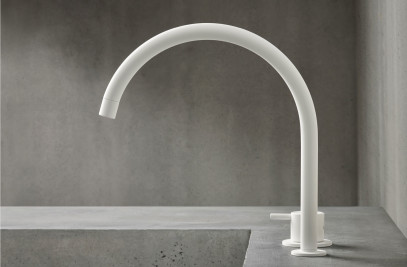Set in the Chiltern Hills, Park Corner Barn was originally part of the neighbouring farm estate and used for agricultural purposes until the1990s.
Built in traditional brick and flint in the late eighteenth century, the barn was enlarged to twice its original size thanks to a Victorian addition in 1864
Our client purchased the barn in 2009, twelve years after the first residential conversion of the building, with the intention of stripping the building back to its basic structure and starting again. We agreed on a strategy to create a series of light, open spaces, Scandinavian in feel, with a sense of calm continuity. The barn had to accommodate his passion for, and collections of, classical music and books, and provide a new focal living space at the centre of the revised layout.
The first conversion of the barn in 1997 appeared to have been an exercise in squeezing as many rooms as possible within the building envelope over two floors, with a lower priority given to the rich material and spatial qualities of the building. This arrangement resulted in a suffocating maze of plasterboard corridors and landings. The success of the project relied on undoing much of this previous work.
This project involved significant re-structuring and re-servicing of the barn. With the removal of many structural walls, floors and beams we had to introduce a complicated package of concealed steelwork and structural timber framing. This was further complicated by the deterioration of the timber elements in the older half of the barn which rendered the primary beams structurally redundant.
Spatially, these changes resulted in two very large living areas. The opening up of the South end of the barn created a vast double-height open plan living room, rising up to the rafters of the main roof and into the gable ends of the transepts. The previously isolated kitchen was knocked-through to become part of an extended, communal living area as the main focus of the house. At the North end, the removal of four en-suite bedrooms provided the space for a dedicated library and music room.
Working with rooms so un-domestic in both provenance and scale, the defining elements within the building needed to have an appropriately heroic and constructed quality to sit comfortably in the spaces around them.
The fireplace and chimney have been conceived as one huge sculpted object: a composition of massive limestone blocks forming the base to a tapering lime-plastered flue, echoing the sloping shapes of rural brick chimney stacks.
The new moveable staircase to the secondary upstairs accommodation weighs one tonne and is completely fabricated from black steel, with a rough textured finish provided by the natural patina of the material.
The oak doors and joinery throughout are deliberately over-scaled to remain generous in appearance, in keeping with the scale of their surroundings.
The barn has been designed with simplicity and is contemporary in attitude to both material and detail. We opted for a limited palette of sober materials to ensure a sense of consistency and calm throughout the building. This reductive attitude towards tone and materiality allows the original fabric of the barn to withstand the additions and remain the predominant feature of the interior.


































